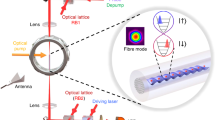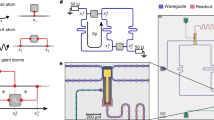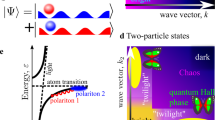Abstract
Considerable efforts have been recently devoted to combining ultracold atoms and nanophotonic devices1,2,3,4 to obtain not only better scalability and figures of merit than in free-space implementations, but also new paradigms for atom–photon interactions5. Dielectric waveguides offer a promising platform for such integration because they enable tight transverse confinement of the propagating light, strong photon–atom coupling in single-pass configurations and potentially long-range atom–atom interactions mediated by the guided photons. However, the preparation of non-classical quantum states in such atom–waveguide interfaces has not yet been realized. Here, by using arrays of individual caesium atoms trapped along an optical nanofibre6,7, we observe a single collective atomic excitation8,9 coupled to a nanoscale waveguide. The stored collective entangled state can be efficiently read out with an external laser pulse, leading to on-demand emission of a single photon into the guided mode. We characterize the emitted single photon via the suppression of the two-photon component and confirm the single character of the atomic excitation, which can be retrieved with an efficiency of about 25%. Our results demonstrate a capability that is essential for the emerging field of waveguide quantum electrodynamics, with applications to quantum networking, quantum nonlinear optics and quantum many-body physics10,11.
This is a preview of subscription content, access via your institution
Access options
Access Nature and 54 other Nature Portfolio journals
Get Nature+, our best-value online-access subscription
$29.99 / 30 days
cancel any time
Subscribe to this journal
Receive 51 print issues and online access
$199.00 per year
only $3.90 per issue
Buy this article
- Purchase on Springer Link
- Instant access to full article PDF
Prices may be subject to local taxes which are calculated during checkout




Similar content being viewed by others
Data availability
The data that support the findings of this study are available from the corresponding author on request.
References
Vetsch, E. et al. Optical interface created by laser-cooled atoms trapped in the evanescent field surrounding an optical nanofiber. Phys. Rev. Lett. 104, 203603 (2010).
Goban, A. et al. Demonstration of a state-insensitive, compensated nanofiber trap. Phys. Rev. Lett. 109, 033603 (2012).
Thompson, J. D. et al. Coupling a single trapped atom to a nanoscale optical cavity. Science 340, 1202–1205 (2013).
Goban, A. et al. Atom-light interactions in photonic crystals. Nat. Commun. 5, 3808 (2014).
Chang, D. E., Douglas, J. S., González-Tudela, A., Hung, C.-L. & Kimble, H. J. Quantum matter built from nanoscopic lattices of atoms and photons. Rev. Mod. Phys. 90, 031002 (2018).
Nieddu, T., Gokhroo, V. & Nic Chormaic, S. Optical nanofibres and neutral atoms. J. Opt. 18, 053001 (2016).
Solano, P. et al. Optical Nanofibers: a new platform for quantum optics. Adv. At. Mol. Opt. Phys. 66, 439–505 (2017).
Duan, L.-M., Lukin, M. D., Cirac, J. I. & Zoller, P. Long-distance quantum communication with atomic ensembles and linear optics. Nature 414, 413–418 (2001).
Sangouard, N., Simon, C., de Riedmatten, H. & Gisin, N. Quantum repeaters based on atomic ensembles and linear optics. Rev. Mod. Phys. 83, 33–80 (2011).
Kimble, H. J. The quantum internet. Nature 453, 1023–1030 (2008).
Chang, D. E., Vuletić, V. & Lukin, M. D. Quantum nonlinear optics – photon by photon. Nat. Photon. 8, 685–694 (2014).
Somaschi, N. et al. Near-optimal single-photon sources in the solid state. Nat. Photon. 10, 340–345 (2016).
Tiecke, T. G. et al. Nanophotonic quantum phase switch with a single atom. Nature 508, 241–244 (2014).
Lodahl, P., Mahmoodian, S. & Stobbe, S. Interfacing single photons and single quantum dots with photonic nanostructures. Rev. Mod. Phys. 87, 347–400 (2015).
Türschmann, P. et al. Chip-based all-optical control of single molecules coherently coupled to a nanoguide. Nano Lett. 17, 4941–4945 (2017).
van Loo, A. F. et al. Photon-mediated interactions between distant artificial atoms. Science 342, 1494–1496 (2013).
Schleier-Smith M. Hybridizing quantum physics and engineering. Phys. Rev. Lett. 117, 100001 (2016).
Pichler, H., Ramos, T., Daley, A. J. & Zoller, P. Quantum optics of chiral spin networks. Phys. Rev. A 91, 042116 (2015).
González-Tudela, A., Paulisch, V., Kimble, H. J. & Cirac, J. I. Efficient multiphoton generation in waveguide quantum electrodynamics. Phys. Rev. Lett. 118, 213601 (2017).
Asenjo-Garcia, A., Moreno-Cardoner, M., Albrecht, A., Kimble, H. J. & Chang, D. E. Exponential improvement in photon storage fidelities using subradiance and “selective radiance” in atomic arrays. Phys. Rev. X 7, 031024 (2017).
Douglas, J. S., Caneva, T. & Chang, D. E. Photon molecules in atomic gases trapped near photonic crystal waveguides. Phys. Rev. X 6, 031017 (2016).
Douglas, J. S. et al. Quantum many-body models with cold atoms coupled to photonic crystals. Nat. Photon. 9, 326–331 (2015).
Dong, Y., Lee, Y.-S. & Choi, K. S. Waveguide QED toolboxes for synthetic quantum matter. Preprint at http://arxiv.org/abs/1712.02020 (2017).
Gouraud, B., Maxein, D., Nicolas, A., Morin, O. & Laurat, J. Demonstration of a memory for tightly guided light in an optical nanofiber. Phys. Rev. Lett. 114, 180503 (2015).
Sayrin, C., Clausen, C., Albrecht, B., Schneeweiss, P. & Rauschenbeutel, A. Storage of fiber-guided light in a nanofiber-trapped ensemble of cold atoms. Optica 2, 353–356 (2015).
Goban, A. et al. Superradiance for atoms trapped along a photonic crystal waveguide. Phys. Rev. Lett. 115, 063601 (2015).
Solano, P., Barberis-Blostein, P., Fatemi, F. K., Orozco, L. A. & Rolston, S. L. Super-radiance reveals infinite-range dipole interactions through a nanofiber. Nat. Commun. 8, 1857 (2017).
Corzo, N. V. et al. Large Bragg reflection from one-dimensional chains of trapped atoms near a nanoscale waveguide. Phys. Rev. Lett. 117, 133603 (2016).
Sørensen, H. L. et al. Coherent backscattering of light off one-dimensional atomic strings. Phys. Rev. Lett. 117, 133604 (2016).
Kuzmich, A. et al. Generation of nonclassical photon pairs for scalable quantum communication with atomic ensembles. Nature 423, 731–734 (2003).
Laurat, J. et al. Efficient retrieval of a single excitation stored in an atomic ensemble. Opt. Express 14, 6912–6918 (2006).
de Riedmatten, H. et al. Direct measurement of decoherence for entanglement between a photon and stored atomic excitation. Phys. Rev. Lett. 97, 113603 (2006).
Chou, C.-W. et al. Functional quantum nodes for entanglement distribution over scalable quantum networks. Science 316, 1316–1320 (2007).
Farrera, P. et al. Generation of single photons with highly tunable wave shape from a cold atomic ensemble. Nat. Commun. 7, 13556 (2016).
Burgers, A. P. et al. Clocked atom delivery to a photonic crystal waveguide. Proc. Natl Acad. Sci. USA 116 456–465 (2019).
Le Kien, F., Balykin, V. I. & Hakuta, K. Atom trap and waveguide using a two-color evanescent field around a subwavelength-diameter optical fiber. Phys. Rev. A 70, 063403 (2004).
Chou, C.-W., Polyakov, S. V., Kuzmich, A. & Kimble, H. J. Single-photon generation from stored excitation in an atomic ensemble. Phys. Rev. Lett. 92, 213601 (2004).
Chou, C.-W. Towards a Quantum Network with Atomic Ensembles. PhD thesis, California Institute of Technology (2006).
Acknowledgements
This work was supported by the European Research Council (Starting grant HybridNet), the Emergence programme from Ville de Paris (project NanoQIP), the DIM Nano-K from Région Ile-de-France, and the PERSU programme from Sorbonne Université (ANR-11-IDEX-0004-02). N.V.C. and A.S.S. acknowledge support from the EU (Marie Curie fellowships Nanofi 659337 and NanoArray 705161), and J.L. thanks the Institut Universitaire de France. We also thank D. Maxein, A. Nicolas and O. Morin for their contributions in the early stage of the experiment.
Reviewer information
Nature thanks D. Chang, M. J. Hartmann and the other anonymous reviewer(s) for their contribution to the peer review of this work.
Author information
Authors and Affiliations
Contributions
N.V.C., J.R. and A.C. performed the experiment. B.G. contributed to the preparation of the setup and A.S.S. to the data analysis. All authors discussed the results and contributed to the writing of the manuscript. J.L. conceived the experiment and supervised its implementation.
Corresponding author
Ethics declarations
Conflict of interest
The authors declare no competing interests.
Additional information
Publisher’s note: Springer Nature remains neutral with regard to jurisdictional claims in published maps and institutional affiliations.
Extended data figures and tables
Extended Data Fig. 1 Filtering system.
The Field-1 beam travels through a filtering system, where it is separated from the dipole trapping beams and the write-field component coupled to the nanofibre. Two cascaded volume Bragg gratings (VBG) provide isolation from the dipole beams, whereas the combination of a polarizing beam splitter (PBS) and a lens cavity (LC) provides the desired isolation from the write beam. The total transmission of the filtering system is around 40%, including fibre coupling. A similar filtering system is used for Field 2.
Extended Data Fig. 2 Timing diagram of the experiment.
After the elongated MOT is loaded, the magnetic field (B) gradient is turned off and the dipole trap is loaded by a transient molasses stage, in which the MOT detuning is increased while the MOT power, as well as the MOT repumping power, are decreased. An additional repumping pulse at the end of the molasses stage is sent to the atoms. After this point, the writing-and-retrieval process starts. The dipole-trapping beams are always on. The full cycle is performed at a repetition rate of 10 Hz.
Extended Data Fig. 3 Dipole trap.
a, Probe transmission (T) spectra as a function of the detuning Δ from resonance for the transition \(\left|6{{\rm{S}}}_{1/2},F=4\right\rangle \to \left|6{{\rm{P}}}_{3/2},F^{\prime} =5\right\rangle \). The fits are given by the function exp[−OD/(1 + (2Δ/Γ)2)], with OD = 97 ± 2 (red), OD = 1.4 ± 0.1 (black) and Γ/(2π) = 5.8 ± 0.2 MHz. b, Decay of the absorption after dipole trap loading. The exponential decay (green solid line) leads to a 25-ms lifetime. The error bars correspond to the propagated Poissonian error of the photon counting probabilities.
Rights and permissions
About this article
Cite this article
Corzo, N.V., Raskop, J., Chandra, A. et al. Waveguide-coupled single collective excitation of atomic arrays. Nature 566, 359–362 (2019). https://doi.org/10.1038/s41586-019-0902-3
Received:
Accepted:
Published:
Issue Date:
DOI: https://doi.org/10.1038/s41586-019-0902-3
This article is cited by
-
Deterministic generation of multidimensional photonic cluster states with a single quantum emitter
Nature Physics (2024)
-
Light–matter interactions in quantum nanophotonic devices
Nature Reviews Physics (2024)
-
On-demand directional microwave photon emission using waveguide quantum electrodynamics
Nature Physics (2023)
-
Bound state in a giant atom-modulated resonators system
npj Quantum Information (2022)
-
Lifetime reductions and read-out oscillations due to imperfect initial level preparations of atoms in a long-lived DLCZ-like quantum memory
Applied Physics B (2022)
Comments
By submitting a comment you agree to abide by our Terms and Community Guidelines. If you find something abusive or that does not comply with our terms or guidelines please flag it as inappropriate.



